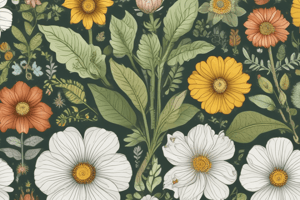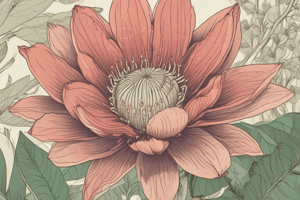Podcast
Questions and Answers
Which of the following is the primary function of petals in a flower?
Which of the following is the primary function of petals in a flower?
- Protecting the ovary
- Producing pollen
- Forming the male parts of the flower
- Attracting pollinators with color and appearance (correct)
The stamen forms the female parts of a flower and produces pollen grains.
The stamen forms the female parts of a flower and produces pollen grains.
False (B)
What part of the flower does pollen travel through to reach the ovary?
What part of the flower does pollen travel through to reach the ovary?
style
The transfer of pollen grains from the anther to the stigma is known as ________.
The transfer of pollen grains from the anther to the stigma is known as ________.
Match the pollination method with its primary mode of transfer:
Match the pollination method with its primary mode of transfer:
What is the main function of the seed coat?
What is the main function of the seed coat?
Seed leaves (cotyledons) provide the tiny hole through which water enters the seed.
Seed leaves (cotyledons) provide the tiny hole through which water enters the seed.
What is the term for a plant in its early stages of development after germination?
What is the term for a plant in its early stages of development after germination?
_______ is the process by which a seed grows into a new plant.
_______ is the process by which a seed grows into a new plant.
Which of the following factors is NOT essential for germination?
Which of the following factors is NOT essential for germination?
What is the primary purpose of seed dispersal?
What is the primary purpose of seed dispersal?
The scattering of seeds away from the parent plant is called ________.
The scattering of seeds away from the parent plant is called ________.
All seeds are dispersed only by wind.
All seeds are dispersed only by wind.
Name two ways by which seeds can be dispersed.
Name two ways by which seeds can be dispersed.
Match the dispersal mechanism with its method
Match the dispersal mechanism with its method
Flashcards
What is a flower?
What is a flower?
The reproductive part of a plant, typically colorful and attractive.
What are petals?
What are petals?
The colorful, attractive parts of a flower.
What are the stamen?
What are the stamen?
Male parts of the flower; the anther produces pollen grains.
What is the pistil?
What is the pistil?
Signup and view all the flashcards
What is pollination?
What is pollination?
Signup and view all the flashcards
What is the seed coat?
What is the seed coat?
Signup and view all the flashcards
What are seed leaves/cotyledons?
What are seed leaves/cotyledons?
Signup and view all the flashcards
What is the embryo in a seed?
What is the embryo in a seed?
Signup and view all the flashcards
What is germination?
What is germination?
Signup and view all the flashcards
What is dispersal?
What is dispersal?
Signup and view all the flashcards
What are invertebrates?
What are invertebrates?
Signup and view all the flashcards
What are vertebrates?
What are vertebrates?
Signup and view all the flashcards
What are cold-blooded animals?
What are cold-blooded animals?
Signup and view all the flashcards
What is camouflage?
What is camouflage?
Signup and view all the flashcards
What are amphibians?
What are amphibians?
Signup and view all the flashcards
Study Notes
- A flower, known as the plant's reproductive part, typically consists of petals, anther, filament, style, stigma, and ovary
- Petals are the flower's most colorful and attractive part
- The anther and filament together form the male parts
- The anther produces pollen grains, which enter the female part
- The style, stigma, and ovary form the female parts
- The style is a long tube with a sticky tip called stigma that has a small opening
- Pollen grains pass through the stigma and style to reach the ovary, leading to the flower changing into a fruit
Pollination and Fruit Formation
- Pollination transfers pollen grains from the anthers to the stigma of a flower
- These pollen grains reach the ovary through the stigma
- Pollination occurs through wind, water, or insects
- After pollination, a flower matures into a fruit, which contains seeds
- Seed coat refers to the outermost layer of the seed
- The seed coat is a thin layer of cover which protects the seed from drying
- A tiny hole in the seed coat allows water entry
- Inside the seed are one or two cotyledons, or seed leaves, that store food for the baby plant growing inside
- When a seed gets air, water, and warmth, it starts growing into a seedling
- The baby plant in the seed, called an embryo, is present between the cotyledons and grows into a new plant after germination
Germination
- A seed with an embryo inside starts growing into a new plant in suitable conditions, called germination
- Germination occurs when the seed is sown in suitable soil, and it gets the required nutrients
- Water enters the seed through the hole in the seed coat
- The seed coat breaks open and the root emerges when the embryo starts to grow
- The shoot starts growing and the seed leaves provide food
- The plant grows, and new leaves develop
- When the stored food finishes, the leaves start making food through photosynthesis
- The new plant continues growing with sufficient air, water, light, and fertile soil
Dispersal of Seeds
- Dispersal means the scattering of seeds away from the mother plant
- Dispersal prevents overcrowding and ensures sufficient resources for growth
- Seeds disperse through wind, water, or animals
- Some fruits burst open when ripe to scatter seeds
- Giant sequoia trees grow from seeds, and their seeds remain buried in the soil for 20 years
- The outer layer opens during forest fires, and the seed grows in bare soil
Types of Animals
- Animals are divided into two groups: invertebrates and vertebrates
- Invertebrates do not have a backbone, ex roaches, ants, snails, and slugs
- Insects' bodies consist of head, thorax, which is a middle portion, and abdomen, and they have six legs
- The head of an insect has eyes, antennae, and a mouth and the antennae help the insect to feel the changes in surroundings
- Most insects have a hard outer covering for protection
- The thorax has legs and wings, allowing some insects to fly
- The abdomen is the segmented body part
- The thorax and abdomen have spiracles for breathing
- Vertebrates have a backbone
- Vertebrates are grouped as fish, reptiles, amphibians, birds, and mammals
Charactistics of Fish, Reptiles and Amphibians
- Fish live in water and have gills and fins to breathe and swim
- Reptiles, including lizards, snakes, turtles, and crocodiles, are cold-blooded because they cannot control their body temperature
- Reptiles' bodies are generally covered with scales
- Crocodiles have horny scales to prevent water loss
- Snakes shed old skin and grow a new one
- Reptiles like turtles and tortoises have a hard shell and can pull their head and feet inside for safety
- Lizards, such as chameleons and iguanas, can change body color for camouflage
- Reptiles lay eggs such as turtles and crocodiles, and they are on shores of oceans and seas to lay eggs
- Reptiles have four limbs for movement such as snakes, however, move by crawling
- Amphibians include frogs, toads, newts, and salamanders, and they can live on land and in water
- Amphibians breathe with lungs when they are on land and through moist skin when in water
- Frogs have long hind limbs to hop
- Frogs croak during the rainy season to attract their partner for mating
- Tadpoles hatch from eggs and breathe with gills in water
Charactistics of Birds and Mammals
- Frogs transform into adults that can live on land as well as in water
- Birds are warm-blooded animals with lightweight bodies covered in feathers
- They fly using their wings
- Flightless birds, such as kiwis, ostriches and penguins, cannot fly
- Mammals give birth to live babies that grow inside the mother's body
- Mammals feed their babies with mother's milk and have distinct characteristics like:
- Hair on the body
- Well-developed brain
- Give birth to young
- Warm-blooded nature Aquatic mammals or those that live in water, such as whales and dolphins, breathe through lungs and come to the surface for air
- The giraffe stands as the world’s tallest mammal, while the elephant holds the distinction of being the largest land mammal
- Interestingly, the blue whale, a marine creature, claims the title of the largest animal on our planet and is also classified as a mammal
Studying That Suits You
Use AI to generate personalized quizzes and flashcards to suit your learning preferences.
Related Documents
Description
Explore the structure of a flower, including petals, anther, filament, style, stigma, and ovary. Learn about pollination, the transfer of pollen grains, and how flowers develop into fruits containing seeds. Understand the role of wind, water, and insects in pollination.




